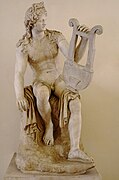Apollo Citharoedus
An Apollo Citharoedus, or Apollo Citharede, is a statue or other image of Apollo with a cithara (lyre).[1]
Notable examples
Vatican
Among the best-known examples is the Apollo Citharoedus, also known as Apollo Musagetes ("Apollo, Leader of the Muses"), of the
Other examples
-
Apollo Altemps, Altemps Palace (Rome)
-
Apollo Citharoedus, a wall-painting from the Palatine Antiquarium
-
Detail of theLouvre)
-
The Apollo Barberini
A marble sculpture now identified as
Other examples include the Apollo of Mantua and the Apollo Barberini, possibly a copy of the cult statue of the Temple of Apollo Palatinus; it is conserved in the Glyptothek, Munich. The Apollo Citaredo in the National Archaeological Museum, Naples is identified as Apollo but is clearly a female figure. Its provenance is unclear; it has been much restored, the head is unlikely to be original and the figure was probably of Vesta.[2]
References
- ISSN 0073-0688.
- ^ Coppa, Antonio. "Apollo Citaredo" (PDF) (in Italian). National Archaeological Museum, Naples.
![]() Media related to Apollo kitharoidos at Wikimedia Commons
Media related to Apollo kitharoidos at Wikimedia Commons





